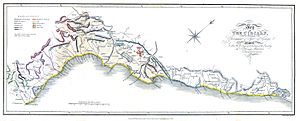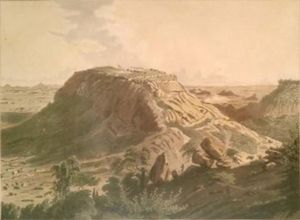Benjamin Heyne facts for kids
Benjamin Heyne FLS (1770, Pirna, Döbra – 6 February 1819, Madras) was a German botanist, naturalist, and surgeon who worked in British India as a Botanist to Samalkot in the Madras Presidency under the British East India Company. He collected and described plants from southern India, many of which were named after him by European botanists.
Life and work in India
The son of German classical scholar and archaeologist Christian Gottlob Heyne and Therese Weiss, daughter of German composer and lutenist Sylvius Leopold Weiss, Benjamin Heyne was born in Döbra, Germany. In later life, Heyne joined the Tranquebar Mission run by Moravians where he took an interest in the botanical gardens. Through William Roxburgh he obtained a position in the Madras Presidency as a botanist at Samalkot around 1794. He was involved in introducing new food plants to overcome famines and these included potatoes and breadfruit. After the fall of Tipu Sultan, he was appointed to look for a new site for a botanical garden in Mysore and he chose Lalbagh. He moved many specimens from Samalkot to Lalbagh. He was formally titled "Naturalist and Botanist" in 1802. Heyne made an observation in 1815 that Bryophyllum calycinum was more acidic in taste in the morning than in the afternoon, among the earliest observations on Crassulacean acid metabolism.
Heyne married Charlotte Rebecca, daughter of L.C. Topander of Jaganaikepuram in May 1803. A mistress, Mrs Maria Clasina Heyne is recorded of having died at Hyderabad on 9 April 1809 while his wife Charlotte died in Bangalore on 29 July 1816. Heyne died at Vepery.
Bangalore collections
In 1800, after the fall of Mysore, the Lalbagh botanical garden at Bangalore was appropriated by the British East India Company "as a depository for useful plants sent from different parts of the country". Dr. Benjamin Heyne, the Company's botanist at Madras, was ordered by the Governor-General, Richard Wellesley to accompany the Surveyor, with the following instructions:
"A decided superiority must be given to useful plants over those which are merely recommended by their rarity or their beauty,... to collect with care all that is connected with the arts and manufacturers of this country, or that promises to be useful in our own; to give due attention to the timber employed in the various provinces of his route,... and to collect with particular diligence the valuable plants connected with his own immediate profession, i.e. medicine."
An important task assigned to the colonial botanical gardens was dealing with malaria, the largest obstacle to colonial expansion. Heyne was placed in charge of the Lalbagh botanical garden till 1812. He did a great deal of collecting at Coimbatore and Bangalore and compiled a large collection of plant specimens which were forwarded to London. He collected more than 350 species from the Western Ghats and more than 200 species were named by him. He sent about 1500 of his Indian botanical specimens to the German botanist Albrecht Wilhelm Roth, whose work Novae plantarum species praesertim Indiae orientali (a book of Indian flora) is largely based on Heyne's botanical specimens.
Mysore survey
Benjamin Heyne was assistant to Francis Buchanan on his Mysore Survey. He recorded in his Journal, his visits to sites with Col. Colin Mackenzie : "To Sautgur Hill (near Conjeeveram) with Mackenzie. Of the Sienite, they made formerly Cannon balls of which many are found lying all over the Hill." and at Nandydroog which was: "this morning cloathed with a white fog, when the rest of the country was Clear. The country hereabouts pretty well cultivated. Yesterday morning was with Capt. Mackenzie in the Fort, in which the houses, very few excepted, were empty. The garden in it that was formerly famous is entirely neglected and nothing in it worth attention but a few apple and coffee Trees." Dr. Benjamin Heyne died at Madras in 1819.



